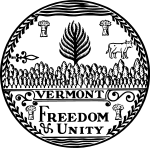| ||||||||||||||||||||
| ||||||||||||||||||||
Sanders: 40–50% 50–60% 60–70% 70–80% 80–90%
Tarrant: 50–60% Tie: 40–50% | ||||||||||||||||||||
| ||||||||||||||||||||
| Elections in Vermont |
|---|
 |
| ||
|---|---|---|
|
Mayor of Burlington
U.S. Representative from
Vermont's at-large district U.S. Senator from Vermont
Presidential campaigns
Published works
|
||
The 2006 United States Senate election in Vermont was held November 7, 2006. Incumbent independent Senator Jim Jeffords decided to retire rather than seek reelection to a fourth term, and Bernie Sanders was elected to succeed him.
Sanders, who represented Vermont's at-large House district as an independent, won the Democratic primary, and then dropped out to run as an independent. Many Democratic politicians across the country endorsed him, and no Democrat was on the ballot. The state committee of the Vermont Democratic Party voted unanimously to endorse Sanders.[1]
Sanders won the seat with 65% of the vote. His win marked the first Republican loss in an election for this Class 1 seat since 1850, decisively ending the longest single-party Senate winning streak in history.[2] (Vermont's Class 3 seat had been held by Democrat Patrick Leahy since 1974, the first time a Republican had lost any Senate election in the state since 1850.)
- ^ Democratic primary is far from ordinary Archived April 5, 2016, at the Wayback Machine (September 11, 2006). Barre-Montpelier Times-Argus.
- ^ The partisan history of every U.S. Senate seat, in 1 awesome chart. The Washington Post.





